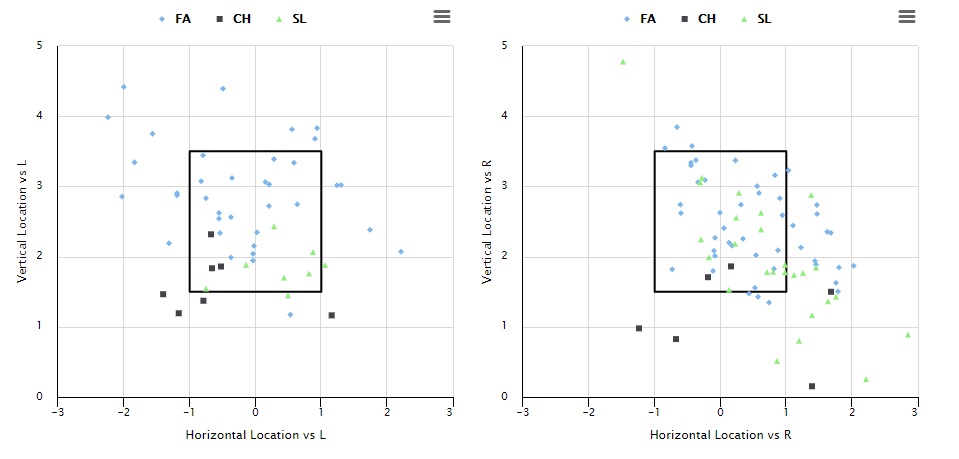(Photo by Quinn Harris/Icon Sportswire)
I’ve said this on here before, but I am a firm, firm believer in the ‘never pay for saves’ adage. Obviously one’s league format could make certain high strikeout relievers more valuable, but in traditional 10-team leagues with rotisserie scoring, overpaying for closers is a wasted pick, in my opinion. Closer’s in 5×5 formats really only contribute in the saves category. The difference between an elite closer like Kenley Jansen and a fringe closer is negligible, especially when Jansen costs a fifth-round pick and a low-end closer can be had on the waiver wire.
Part of my disdain for drafting closers is that so many get traded at the trade deadline, often getting dealt to teams that already have an established closer. While this can be massively inconvenient for the fantasy owner who loses an elite closer, it can tremendously benefit owners who are savvy enough to scoop up the rebuilding teams new ninth-inning man. While it’s not always easy to identify which closers are going to be dealt, and who is going to replace them, there is a fairly obvious second half closer (SHC?) developing in the Motor City, and that’s 23-year-old Joe Jimenez.
Detroit’s Closer of the Future
For those just getting introduced to Jimenez, allow me to fill you in. He has been one of Detroit’s top prospects for the last few years after absolutely carving hitters up through the minor leagues. In 167 1/3 minor league innings, Jimenez posted a 1.56 ERA and a 0.98 WHIP. He had a 13.0 K/9 with a tidy 2.8 BB/9. There’s a reason Tigers fans were so hyped for his big league debut, which came part way through the 2017 season. While Jimenez did not impress in his first taste of the show, he managed to run into an incredible amount of misfortune. His 4.26 BB/9 was a frightening development, but his 8.05 K/9 was still respectable. He also suffered from a .403 BABIP and a 38.5% strand rate. While his 5.84 FIP and 4.81 SIERA aren’t great by any means, they paint a slightly less egregious picture than the 12.32 ERA and 2.11 WHIP that he actually posted.
Going into 2018, Jimenez was expected to serve in a middle relief capacity, with possible trips to Triple-A Toledo if he struggled. Shane Greene is the no doubt closer in Detroit, and Alex Wilson and Daniel Stumpf were expected to fill in the late innings. However, Jimenez has come out firing on all cylinders to start the 2018 season.
So far in 2018, Jimenez has thrown 8 2/3 innings without allowing a run. He has an 8.31 K/9 and a 2.07 BB/9, down nearly two walks from last year. More importantly, he has picked up the eighth inning role for the Tigers. The incumbent Wilson is off to an ugly start this year, with a 5.40 ERA. He does not figure to be a part of the team’s future, so getting Jimenez into high-leverage roles is paramount for the Tigers to assess his ability to close for them in the future.
That future is almost certainly going to be the second half of 2018, as the Tigers are expected to shop Greene at the trade deadline. If Jimenez inherits the ninth-inning role in Detroit, he is worth an add in nearly all fantasy formats. Taking a look at his repertoire, it’s easy to get excited about his potential as a closer.
Joe Jimenez Pitch Mix
Jimenez has a typical three-pitch mix: fastball slider changeup. He uses the fastball about 63% of the time, with the slider (27%) and changeup (10%) following suit. He has adjusted the way he attacks hitters this season, and the results speak for themselves. Take a look at the chart below, showing how Jimenez uses his arsenal against both right and left-handers.

The biggest change we’ve seen from Jimenez is a more aggressive approach with his fastball. Jimenez has started to utilize the high heat more this year, which has led to considerably more pop-ups. In 2017 Jimenez had a 25.6% line drive rate and a 48.7% fly ball rate. This year (again, the sample size is small) he has seen the line drive rate drop to 7.7% and the fly ball rate catapult up to 76.9%. While those numbers are likely to normalize as the year goes on, it does line up with his shift in approach on the mound. For a guy who can get his fastball up into the high-90’s, a fastball at the top of the zone is a lethal weapon. Two examples below (finally, GIFs!) help demonstrate how Jimenez effectively uses this pitch:
[gfycat data_id=”ShockingSecondhandAtlanticsharpnosepuffer”]
[gfycat data_id=”SprySlimAnnelid”]
Not much else a hitter can do with this pitch besides pop it up, which helps explain Jimenez’s 30% infield fly ball rate on the year.
Jimenez’s slider has undergone a pretty significant change from a year ago. In 2017, Jimenez’s slider had 1.6 inches of horizontal movement, compared to 3.4 inches of vertical movement. Basically, it was more like a soft sinker that didn’t have a ton of movement. So far in 2018 however, Jimenez’s slider has 5.1 inches of horizontal movement and just 0.2 inches of vertical movement. So now it looks like a sweeping slider that moves directly away from a right-handed bat. Or, in the case below, directly into a left-hander.
[gfycat data_id=”PaleBlindKookaburra”]
Who doesn’t love a good front door slider? Sample is too small to make any big generalizations, but Jimenez has improved his zone rate by over 10% since adopting a more horizontal slider. Assuming this change helps him locate better, it should benefit him in the long run.
Last up is the changeup. Jimenez gets a ton of arm-side run on his change, with nearly nine inches of horizontal movement in on a right-hander. He relies primarily on his fastball/slider combo, but that doesn’t mean he can’t occasionally embarrass a left-handed hitter with this pitch, like he did below to Nicky Delmonico.
[gfycat data_id=”JointHideousLeafhopper”]
For fantasy owners looking for saves down the stretch, Jimenez is absolutely an arm worth keeping an eye on. If he keeps pitching well, he is a shoo-in to take over the ninth inning when the Tigers inevitably trade Greene for prospects. The small adjustments he’s made in his approach and his new slider should make him a closer worth owning in all fantasy formats.
Every year, a handful of second half closers emerge from rebuilding teams. Grabbing one or two of them can help catapult a team to success. Savvy fantasy owners will want to keep an eye on Jimenez, as he could be the key to a successful second half.

